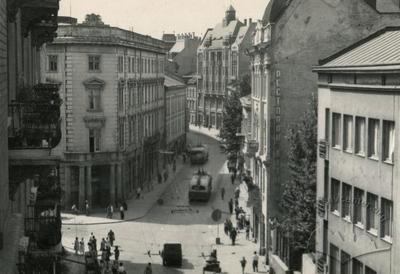Vul. Akademika Hnatiuka, 20-22 – residential and office building
The building was built under a project designed by Ferdynand Kassler and Roman Feliński, noted Lviv architects, and developed at the architectural bureau of Michał Ulam. It is an illustrative example of a residential townhouse, whose modern plasticity combines architectural elements and the sculptural decoration made by Zygmunt Kurczyński. The building is an architectural monument (protection number 770). Now it is used for dwelling purposes; the ground floor premises are occupied by the City railway ticket offices for advance sale.
Architecture
The two-storied townhouse is built of brick and plastered; it is based on the H-shaped plan. It consists of two parallel rectangular buildings (a main one and a rear one), connected by a narrower block (with a staircase and a lift shaft), with a courtyard. The main building is covered with a high complete roof while the central part is covered with a higher fractured roof, accentuated by a tent dome with a lantern. The rear building is covered with a complete roof. The frame constructive structure is formed of bearing pillars and reinforced concrete beams.
The façade is designed after the pattern of the German Modernism whose shapes are combined with stylized Neo-Classicist elements. The main façade composition has six axes with the main entrance located on the second axis on the left. The rusticated façade surfaces emphasize the building’s constructive arrangement. The main façade’s compositional design is expressed in the plastic forms of small balconies and three-storied bay windows overhanging over the ground floor large three-centered window openings. The gate-passage portal is decoratively flanked with statues stylized in the spirit of ancient Egypt (Zygmunt Kurczyński). Two lateral bay windows with three-part windows are flanked by pilasters with stylized capitals and topped with fractured half domes, laying on a balustrade belt. On the lower tier level the bay windows are connected by balconies with modernly patterned lattices. The side bay windows between the second and third floors windows are decorated with bas-reliefs depicting allegories of art and military courage (Zygmunt Kurczyński). The middle part of the façade is crowned with a simple cornice decorated with acanthus leaves. The lateral three-part axes of the façade are topped with triangular pediments having rectangular window openings, accentuated by small balconies. The door opening of the main entrance is located in a rectangular niche; the three-part door is made of metal, with glass panes and geometrically patterned lattices. The courtyard façades are decorated in a strict manner; the wings have semicircular latticed balconies.
As regards the interior spatial design of the both parts of the building, it has a two-tract structure, divided by construction columns or by narrow bearing walls. A large representative staircase is arranged between the main part and the back part. A large gate-passage leads to a small courtyard, as well as to another staircase consisting of two flights. The gate-passage and staircase decoration is characteristically featured by framed divisions on the walls, connected by geometric decorations. The lower part is painted in darker colors contrasting with the upper parts of the walls. All interior design decorative elements (stone cladding, balustrades, lamps and metal details) are made with precision in geometric forms. The paired pilasters of the gate-passage are topped with paired putti sculptures (Zygmunt Kurczyński). The townhouse’s modern plasticity combines stylized architectural elements and sculptural decoration.
Related Places
Personalities
Izak Losch – co-owner of the previous real estate in 1884-1910
Ferdynand Kassler – a famous Lviv architect who worked in the Ulam architectural bureau in 1908-1911 and designed the Grüner townhouse
Michał Ulam – architect and owner of an architectural bureau where the building was designed
Aleksander Wolski – President of the Association of Polish Journalists was got a license to operate the cinema in 1916
Sources
2. DALO 2/1/2878.
3. Central State Historical Archives of Ukraine in Lviv (CDIAL) 186/8/629.
4. Gierszewska Barbara, Kino i film we Lwowie do 1939 roku (Kielce: Wydawnictwo Akademii Świętokrzyskiej, 2006), 428.
5. Lewicki J., Między tradycją a nowoczesnością. Architektura Lwowa lat 1893–1918 (Warszawa, 2005), 345-348.
6. Бірюльов Юрій, Мистецтво львівської сецесії (Львів: Центр Європи, 2005).
7. Мельник Б. В., Довідник перейменування вулиць і площ Львова (Львів: Світ, 2001).
Media Archive Materials
Related Pictures











